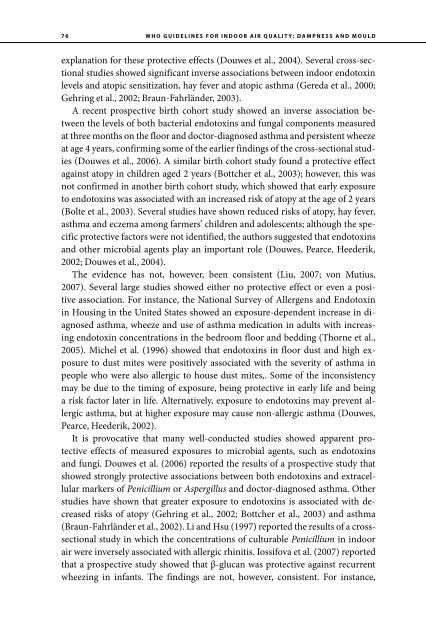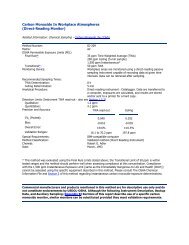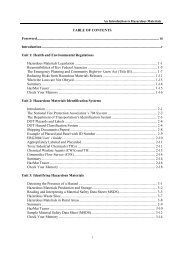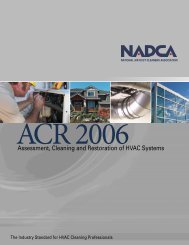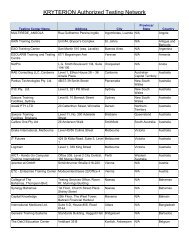Dampness and Mould - WHO guidelines for indoor air quality - PRWeb
Dampness and Mould - WHO guidelines for indoor air quality - PRWeb
Dampness and Mould - WHO guidelines for indoor air quality - PRWeb
You also want an ePaper? Increase the reach of your titles
YUMPU automatically turns print PDFs into web optimized ePapers that Google loves.
76<br />
<strong>WHO</strong> GUIDELINES FOR INDOOR AIR QUALITY: DAMPNESS AND MOULD<br />
explanation <strong>for</strong> these protective effects (Douwes et al., 2004). Several cross-sectional<br />
studies showed significant inverse associations between <strong>indoor</strong> endotoxin<br />
levels <strong>and</strong> atopic sensitization, hay fever <strong>and</strong> atopic asthma (Gereda et al., 2000;<br />
Gehring et al., 2002; Braun-Fahrländer, 2003).<br />
A recent prospective birth cohort study showed an inverse association between<br />
the levels of both bacterial endotoxins <strong>and</strong> fungal components measured<br />
at three months on the floor <strong>and</strong> doctor-diagnosed asthma <strong>and</strong> persistent wheeze<br />
at age 4 years, confirming some of the earlier findings of the cross-sectional studies<br />
(Douwes et al., 2006). A similar birth cohort study found a protective effect<br />
against atopy in children aged 2 years (Bottcher et al., 2003); however, this was<br />
not confirmed in another birth cohort study, which showed that early exposure<br />
to endotoxins was associated with an increased risk of atopy at the age of 2 years<br />
(Bolte et al., 2003). Several studies have shown reduced risks of atopy, hay fever,<br />
asthma <strong>and</strong> eczema among farmers’ children <strong>and</strong> adolescents; although the specific<br />
protective factors were not identified, the authors suggested that endotoxins<br />
<strong>and</strong> other microbial agents play an important role (Douwes, Pearce, Heederik,<br />
2002; Douwes et al., 2004).<br />
The evidence has not, however, been consistent (Liu, 2007; von Mutius,<br />
2007). Several large studies showed either no protective effect or even a positive<br />
association. For instance, the National Survey of Allergens <strong>and</strong> Endotoxin<br />
in Housing in the United States showed an exposure-dependent increase in diagnosed<br />
asthma, wheeze <strong>and</strong> use of asthma medication in adults with increasing<br />
endotoxin concentrations in the bedroom floor <strong>and</strong> bedding (Thorne et al.,<br />
2005). Michel et al. (1996) showed that endotoxins in floor dust <strong>and</strong> high exposure<br />
to dust mites were positively associated with the severity of asthma in<br />
people who were also allergic to house dust mites,. Some of the inconsistency<br />
may be due to the timing of exposure, being protective in early life <strong>and</strong> being<br />
a risk factor later in life. Alternatively, exposure to endotoxins may prevent allergic<br />
asthma, but at higher exposure may cause non-allergic asthma (Douwes,<br />
Pearce, Heederik, 2002).<br />
It is provocative that many well-conducted studies showed apparent protective<br />
effects of measured exposures to microbial agents, such as endotoxins<br />
<strong>and</strong> fungi. Douwes et al. (2006) reported the results of a prospective study that<br />
showed strongly protective associations between both endotoxins <strong>and</strong> extracellular<br />
markers of Penicillium or Aspergillus <strong>and</strong> doctor-diagnosed asthma. Other<br />
studies have shown that greater exposure to endotoxins is associated with decreased<br />
risks of atopy (Gehring et al., 2002; Bottcher et al., 2003) <strong>and</strong> asthma<br />
(Braun-Fahrländer et al., 2002). Li <strong>and</strong> Hsu (1997) reported the results of a crosssectional<br />
study in which the concentrations of culturable Penicillium in <strong>indoor</strong><br />
<strong>air</strong> were inversely associated with allergic rhinitis. Iossifova et al. (2007) reported<br />
that a prospective study showed that β-glucan was protective against recurrent<br />
wheezing in infants. The findings are not, however, consistent. For instance,


